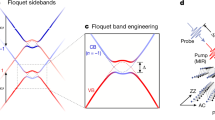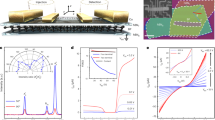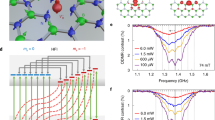Abstract
Semiconductor devices rely on the charge and spin of electrons, but there is another electronic degree of freedom called pseudospin in a two-level quantum system1 such as a crystal consisting of two sublattices2. A potential way to exploit the pseudospin of electrons in pseudospintronics3,4,5 is to find quantum matter with tunable and sizeable pseudospin polarization. Here, we propose a bipolar pseudospin semiconductor, where the electron and hole states have opposite net pseudospin polarization. We experimentally identify such states in anisotropic honeycomb crystal—black phosphorus. By sublattice interference of photoelectrons, we find bipolar pseudospin polarization greater than 95% that is stable at room temperature. This pseudospin polarization is identified as a consequence of Dirac cones merged in the highly anisotropic honeycomb system6,7. The bipolar pseudospin semiconductor, which is a pseudospin analogue of magnetic semiconductors, is not only interesting in itself, but also might be useful for pseudospintronics.
This is a preview of subscription content, access via your institution
Access options
Access Nature and 54 other Nature Portfolio journals
Get Nature+, our best-value online-access subscription
$29.99 / 30 days
cancel any time
Subscribe to this journal
Receive 12 print issues and online access
$259.00 per year
only $21.58 per issue
Buy this article
- Purchase on Springer Link
- Instant access to full article PDF
Prices may be subject to local taxes which are calculated during checkout




Similar content being viewed by others
Data availability
The data that supports the findings of this study are available from the corresponding author on reasonable request.
References
Yang, K. et al. Quantum ferromagnetism and phase transitions in double-layer quantum Hall systems. Phys. Rev. Lett. 72, 732–735 (1994).
Geim, A. K. & MacDonald, A. H. Graphene: exploring carbon flatland. Phys. Today 60, 35–41 (2007).
Pesin, D. & MacDonald, A. H. Spintronics and pseudospintronics in graphene and topological insulators. Nat. Mater. 11, 409–415 (2012).
Soleimanikahnoj, S. & Knezevic, K. Pseudospin electronics in phosphorene nanoribbons. Phys. Rev. Appl. 8, 064021 (2017).
Ang, Y. S., Yang, S. A., Zhang, C., Ma, Z. & Ang, L. K. Valleytronics in merging Dirac cones: all-electric-controlled valley filter, valve and universal reversible logic gate. Phys. Rev. B 96, 245410 (2017).
Montambaux, G., Piéchon, F., Fuchs, J.-N. & Goerbig, M. O. A universal Hamiltonian for motion and merging of Dirac points in a two-dimensional crystal. Eur. Phys. J. B 72, 509–520 (2009).
Pereira, V. M. & Castro Neto, A. H. Tight-binding approach to uniaxial strain in graphene. Phys. Rev. B 80, 045401 (2009).
Ren, Y., Qiao, Z. & Niu, Q. Topological phases in two-dimensional materials: a review. Rep. Prog. Phys. 79, 066501 (2016).
Li, X., Wu, X., Li, Z., Yang, J. & Hou, J. G. Bipolar magnetic semiconductors: a new class of spintronics materials. Nanoscale 4, 5680–5685 (2012).
Li, X. & Yang, J. First-principles design of spintronics materials. Natl Sci. Rev 3, 365–381 (2016).
Ezawa, M. Topological origin of quasi-flat edge band in phosphorene. New J. Phys. 16, 115004 (2014).
de Sousa, D. J. P., de Castro, L. V., da Costa, D. R., Milton Pereira, J. Jr. & Low, T. Multilayered black phosphorus: from a tight-binding to a continuum description. Phys. Rev. B 96, 155427 (2017).
Morita, A. Semiconducting black phosphorus. Appl. Phys. 39, 227–242 (1986).
Liu, Q., Zhang, X., Abdalla, L. B., Fazzio, A. & Zunger, A. Switching a normal insulator into a topological insulator via electric field with application to phosphorene. Nano Lett. 15, 1222–1228 (2015).
Kim, J. et al. Observation of tunable band gap and anisotropic Dirac semimetal state in black phosphorus. Science 349, 723–726 (2015).
Kim, J. et al. Two-dimensional Dirac fermions protected by space-time inversion symmetry in black phosphorus. Phys. Rev. Lett. 119, 226801 (2017).
Mucha-Kruczyński, M. et al. Characterization of graphene through anisotropy of constant-energy maps in angle-resolved photoemission. Phys. Rev. B 77, 195403 (2008).
Liu, Y., Bian, G., Miller, T. & Chiang, T.-C. Visualizing electronic chirality and Berry phases in graphene systems using photoemission with circularly polarized light. Phys. Rev. Lett. 107, 166803 (2011).
Hwang, C. et al. Direct measurement of quantum phases in graphene via photoemission spectroscopy. Phys. Rev. B 84, 125422 (2011).
Jung, S. W. et al. Sublattice interference as the origin of σ band kinks in graphene. Phys. Rev. Lett. 116, 186802 (2016).
Tarnowski, M. et al. Observation of topological Bloch-state defects and their merging transition. Phys. Rev. Lett. 118, 240403 (2017).
Mucha-Kruczyński, M., Aleiner, I. L. & Fal’ko, V. I. Strained bilayer graphene: band structure topology and Landau level spectrum. Phys. Rev. B 84, 041404 (2011).
Li, P. & Appelbaum, I. Electrons and holes in phosphorene. Phys. Rev. B 90, 115439 (2014).
Qiao, J., Kong, X., Hu, Z.-X., Yang, F. & Ji, W. High-mobility transport anisotropy and linear dichroism in few-layer black phosphorus. Nat. Commun. 5, 4475 (2014).
Wang, X. et al. Highly anisotropic and robust excitons in monolayer black phosphorus. Nat. Nanotechnol. 10, 517–521 (2015).
Nualpijit, P., Sinner, A. & Ziegler, K. Tunable transmittance in anisotropic two-dimensional materials. Phys. Rev. B 97, 235411 (2018).
Bullock, J. et al. Polarization-resolved black phosphorus/molybdenum disulphide mid-wave infrared photodiodes with high detectivity at room temperature. Nat. Photon. 12, 601–607 (2018).
Xiong, F., Zhang, J., Zhu, Z., Yuan, X. & Qin, S. Strong anisotropic perfect absorption in monolayer black phosphorus and its application as tunable polarizer. J. Opt. 19, 075002 (2017).
Du, R. et al. Tuning anti-Klein tunneling in bilayer graphene. Phys. Rev. Lett. 121, 127706 (2018).
Rycerz, A., Tworzydło, J. & Beenakker, C. W. J. Valley filter and valley valve in graphene. Nat. Phys. 3, 172–175 (2007).
Rudenko, A. N. & Katsnelson, M. I. Quasiparticle band structure and tight-binding model for single- and bilayer black phosphorus. Phys. Rev. B 89, 201408 (2014).
Naumis, G. G., Barraza-Lopez, S., Oliva-Leyva, M. & Terrones, H. Electronic and optical properties of strained graphene and other strained 2D materials: a review. Rep. Prog. Phys. 80, 096501 (2017).
Moser, S. An experimentalist’s guide to the matrix element in angle resolved photoemission. J. Electron Spectrosc. Relat. Phenom. 214, 29–52 (2017).
Acknowledgements
This work was supported by the National Research Foundation (NRF) of Korea (grants nos. 2017R1A2B3011368, 2017R1A5A1014862 and 2018K1A3A7A09027641) and the Future-leading Research Initiative of 2019-22-0079 of Yonsei University. The Advanced Light Source is supported by the US Department of Energy, Office of Sciences, under contract no. DE-AC02-05CH11231. We thank K. Moon, B.-J. Yang, Y.W. Son and J.-W. Rhim for helpful discussions and D.Y. Park for help with experiments.
Author information
Authors and Affiliations
Contributions
S.W.J., S.H.R., W.J.S., Y.S. and M.H. conducted ARPES experiments with help from R.J.K., C.J., E.R. and A.B. S.W.J. performed tight-binding band calculations and spectral simulations. K.S.K. directed the project. S.W.J., S.H.R. and K.S.K. wrote the manuscript with contributions from all other co-authors.
Corresponding author
Ethics declarations
Competing interests
The authors declare no competing interests.
Additional information
Publisher’s note Springer Nature remains neutral with regard to jurisdictional claims in published maps and institutional affiliations.
Extended data
Extended Data Fig. 1 Pseudospin texture in graphene and BP.
The pseudospin texture is calculated with tight-binding models (Methods) and shown in the vector plot for graphene and BP with different Δ marked at the top. The arrows shown in different colours indicate the direction of pseudospin polarization (ϕ is 0, π, ±π/2 for blue, red, green, and yellow arrows, as in Figs. 1e–g and 4a, b). Black dots represent Dirac points.
Extended Data Fig. 2 Experimental geometry and selective excitation of pseudospin polarization.
a, Scattering plane of photon-in (blue arrow) and photoelectron-out (red arrow) aligned to the zigzag (ZZ) axis of BP. With this geometry, linear horizontal (LH) and linear vertical (LV) polarization corresponds to ZZ and AC polarization, respectively. The analyzer slit is rotatable between the horizontal slit to measure ARPES spectra in kZZ and the vertical slit to measure those in kAC with no change in the scattering plane. b, Selective excitation of pseudospin states by variable polarization. The superposition of wavefunctions in A and B sublattices |A〉+eiϕ|B〉 are represented on the Bloch sphere by pseudospin arrows in colour (ϕ is 0, π, ±π/2 for blue, red, green, and yellow arrows). On top of each sphere, the double-head or curved arrows show light polarization allowed to excite corresponding pseudospin states by sublattice interference (Methods).
Extended Data Fig. 3 Temperature dependence of pseudospin polarization in BP.
ARPES spectra of BP at 30 K (top) and 300 K (bottom), taken with linearly polarized light marked at the top. Red and blue curves show the expected locations of VB and CB, respectively. Corresponding line profiles taken at k = 0 are shown on the right.
Extended Data Fig. 4 Photon-energy dependence of pseudospin polarization in BP.
ARPES spectra of BP taken along the AC direction with the photon energy of 60–200 eV. The photon energy is converted to k in the out-of-plane axis (kz) with the inner potential of 10 eV. Constant-energy maps as a function of kAC and kz are shown at –0.23 eV, where the uniform intensity of VB in data of AC-polarized light is suppressed at k < ±0.1 Å−1 in that of ZZ-polarized light. This suppression is unexceptionally observed in all the photon energies, ruling out the possibility of final-state effects. The dispersion along kz is due to the bulk bandstructure of BP, and the fringe patterns near kz = 4.2–4.3 Å−1 is due to the overlap of core-level spectra excited by the second harmonic photons.
Extended Data Fig. 5 Evolution of pseudospin polarization in BP across the band inversion.
A series of ARPES data taken from bulk BP with Δ controlled by surface doping, as marked at the top. ARPES data in the top row were taken along kZZ with AC- polarized light (AC-pol), and those in the middle row were taken with ZZ-polarized light (ZZ-pol). Shown at the bottom row is the difference of ARPES intensity taken by AC-polarized light (IAC) and ZZ-polarized light (IZZ) after normalization. Red and blue dotted lines show the expected locations of hole and electron states, respectively. Black dotted lines indicate the charge-neutrality energy.
Extended Data Fig. 6 Experimental pseudospin polarization in band-inverted BP.
a,b, ARPES data taken from surface-doped bulk BP with Δ = –0.6 eV with AC-polarized light (AC-pol) and zigzag-polarized light (ZZ-pol). c, Difference of ARPES intensity taken with AC-pol. (IAC) and ZZ-pol. (IZZ) after normalization. d, Difference of those taken with LC-polarized (ILC) and RC-polarized (IRC) light. e-h, Constant-energy maps at –0.45 eV taken with the corresponding polarization conditions as marked at the top.
Extended Data Fig. 7 Pseudospin order in anisotropic honeycomb systems across the topological phase transition.
a, Bandstructure of anisotropic honeycomb systems for the three representative cases, Δ > 0 for the normal state, Δ = 0 for the critical point, and Δ < 0 for the Dirac semimetal state. The arrows overlaid show pseudospins in the same colour as defined in Extended Data Fig. 2b. b, Corresponding pseudospin textures calculated with the tight-binding model of BP as a function of Δ controlled by vertical electric field (Methods). c, Corresponding pseudospin textures calculated by the tight-binding model of graphene as a function of Δ controlled by uniaxial strain (Methods).
Extended Data Fig. 8 Quantum tunnelling through the pseudospin interface.
a, Band diagram of BP made in a form of the pseudospin interface. The pseudospin polarization is shown in the same colour as in Extended Data Fig. 7. Owing to the pseudospin conservation as in the p-n junction of bilayer graphene29, the current passing through this pseudospin interface was predicted to exhibit anti-Klein tunnelling and giant pseudo-magnetoresistance, the key mechanism of a pseudospin valve with a large on-off ratio3. b, Conceptual diagram of a pseudospin valve that can be switched on and off by the gate polarity in the middle region.
Rights and permissions
About this article
Cite this article
Jung, S.W., Ryu, S.H., Shin, W.J. et al. Black phosphorus as a bipolar pseudospin semiconductor. Nat. Mater. 19, 277–281 (2020). https://doi.org/10.1038/s41563-019-0590-2
Received:
Accepted:
Published:
Issue Date:
DOI: https://doi.org/10.1038/s41563-019-0590-2
This article is cited by
-
Pseudospin-selective Floquet band engineering in black phosphorus
Nature (2023)
-
Spin-polarized and possible pseudospin-polarized scanning tunneling microscopy in kagome metal FeSn
Communications Physics (2022)
-
Pseudogap in a crystalline insulator doped by disordered metals
Nature (2021)
-
Understanding adsorption geometry of organometallic molecules on graphite
Scientific Reports (2021)
-
Light-induced emergent phenomena in 2D materials and topological materials
Nature Reviews Physics (2021)



